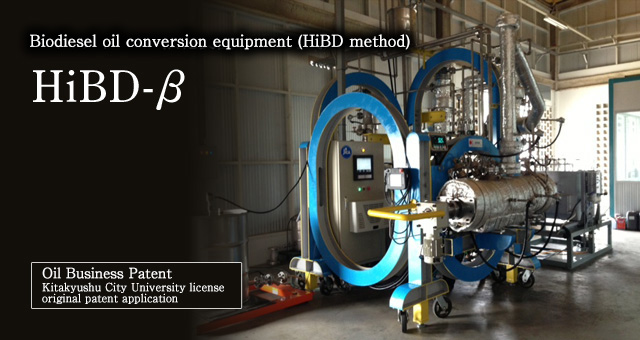Biodiesel oil conversion equipment(HiBD method)

Biodiesel production equipment "HiBD-β" delivered to Chulalongkorn University in Thailand as part of JICA/JST's SATREPS project (Japan-Thailand joint research on new biodiesel).
Catalytic cracking using a catalyst removes oxygen-containing components from waste cooking oil and fats and oils containing impurities, producing hydrocarbons mainly composed of olefins and paraffins with 9 to 24 carbon atoms without producing by-products, with high efficiency and low cost. Generate. ``BDF (FAME)'', which is a conventional oil conversion method using methanol, produces fatty acid methyl ester, whereas ``HiBD'', which can produce hydrocarbon oil, is of high quality, so it can be used for engine resin and rubber. There is no deterioration of parts, no acid/sludge generation, and no quality deterioration due to heat effects. Therefore, it is said that the limit for the mixing ratio of BDF to light oil is 20 to 30%, but with HiBD it is possible to use 100% neat.
Main features
Compared to the conventional methods BDF (FAME) and BHD, it has the following superior features.
- 1.
- BDF (FAME) requires methanol, BHD requires hydrogen, but HiBD only requires an inexpensive catalyst.
- 2.
- BDF (FAME) produces glycerin as a by-product and requires a water washing process and wastewater treatment to separate it, but HiBD does not.
- 3.
- Since the reaction is carried out at around 400°C and normal pressure, the equipment is simple and equipment costs are low, making it possible to operate even in small-scale facilities.
- 4.
- Because it has a low pour point (-15℃ or less), it can be used as diesel fuel without being blended with light oil.
Produced oil
The resulting oil is a mixture of approximately 80% diesel (light oil) and 20% gasoline (naphtha).
Fractional distillation of these products further expands their uses.
Examples of main uses of produced oil
 Fuel for vehicles, ships, heavy machinery, agricultural machinery, etc.
Fuel for turbine generators, rotary generators, etc.
Fuel for industrial furnaces, incinerators, boilers, etc.
Agricultural and household heating fuel.
Fuel for vehicles, ships, heavy machinery, agricultural machinery, etc.
Fuel for turbine generators, rotary generators, etc.
Fuel for industrial furnaces, incinerators, boilers, etc.
Agricultural and household heating fuel.




